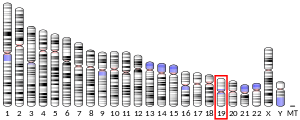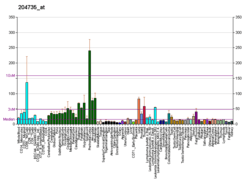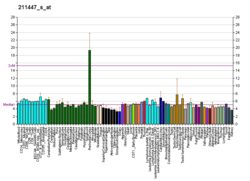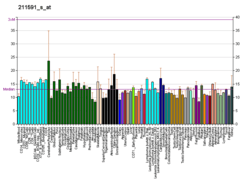PDE4A
cAMP-specific 3',5'-cyclic phosphodiesterase 4A is an enzyme that in humans is encoded by the PDE4A gene.[5][6]
Function
The protein encoded by this gene belongs to the cyclic nucleotide phosphodiesterase (PDE) family, and PDE4 subfamily. This PDE hydrolyzes the secondary messenger, cAMP, which is a regulator and mediator of a number of cellular responses to extracellular signals. Thus, by regulating the cellular concentration of cAMP, this protein plays a key role in many important physiological processes.[6] Recently, it has been shown through the use of PDE4A knock out mice that PDE4A may play a role in the regulation of anxiety and emotional memory.[7]
Clinical significance
PDE4A is a target of a number of drugs including:[8][9][10]
- rolipram (antidepressant and antiinflammatory) and cilomilast (antiinflammatory) – inhibits PDE4A isoforms 1, 2, 6, and 7
- roflumilast (antiinflammatory) – inhibits PDE4A isoforms 1, 2, and 6
References
- GRCh38: Ensembl release 89: ENSG00000065989 - Ensembl, May 2017
- GRCm38: Ensembl release 89: ENSMUSG00000032177 - Ensembl, May 2017
- "Human PubMed Reference:". National Center for Biotechnology Information, U.S. National Library of Medicine.
- "Mouse PubMed Reference:". National Center for Biotechnology Information, U.S. National Library of Medicine.
- Milatovich A, Bolger G, Michaeli T, Francke U (Mar 1994). "Chromosome localizations of genes for five cAMP-specific phosphodiesterases in man and mouse". Somatic Cell and Molecular Genetics. 20 (2): 75–86. doi:10.1007/BF02290677. PMID 8009369.
- "PDE4A phosphodiesterase 4A, cAMP-specific ( Homo sapiens )". Entrez Gene. 2012-03-04. Retrieved 2012-04-02.
- Hansen RT, Conti M, Zhang H-T (2014). "Mice deficient in phosphodiesterase-4A display anxiogenic-like behavior". Psychopharmacology. 231 (15): 2941–2954. doi:10.1007/s00213-014-3480-y. PMID 24563185.
- Rena G, Begg F, Ross A, MacKenzie C, McPhee I, Campbell L, Huston E, Sullivan M, Houslay MD (May 2001). "Molecular cloning, genomic positioning, promoter identification, and characterization of the novel cyclic amp-specific phosphodiesterase PDE4A10" (PDF). Molecular Pharmacology. 59 (5): 996–1011. doi:10.1124/mol.59.5.996. PMID 11306681.
- Wallace DA, Johnston LA, Huston E, MacMaster D, Houslay TM, Cheung YF, Campbell L, Millen JE, Smith RA, Gall I, Knowles RG, Sullivan M, Houslay MD (Jun 2005). "Identification and characterization of PDE4A11, a novel, widely expressed long isoform encoded by the human PDE4A cAMP phosphodiesterase gene". Molecular Pharmacology. 67 (6): 1920–34. doi:10.1124/mol.104.009423. PMID 15738310.
- Mackenzie KF, Topping EC, Bugaj-Gaweda B, Deng C, Cheung YF, Olsen AE, Stockard CR, High Mitchell L, Baillie GS, Grizzle WE, De Vivo M, Houslay MD, Wang D, Bolger GB (Apr 2008). "Human PDE4A8, a novel brain-expressed PDE4 cAMP-specific phosphodiesterase that has undergone rapid evolutionary change". The Biochemical Journal. 411 (2): 361–9. doi:10.1042/BJ20071251. PMC 4337886. PMID 18095939.
Further reading
- Houslay MD, Schafer P, Zhang KY (Nov 2005). "Keynote review: phosphodiesterase-4 as a therapeutic target". Drug Discovery Today. 10 (22): 1503–19. doi:10.1016/S1359-6446(05)03622-6. PMID 16257373.
- Zhang KY, Ibrahim PN, Gillette S, Bollag G (Dec 2005). "Phosphodiesterase-4 as a potential drug target". Expert Opinion on Therapeutic Targets. 9 (6): 1283–305. doi:10.1517/14728222.9.6.1283. PMID 16300476.
- Livi GP, Kmetz P, McHale MM, Cieslinski LB, Sathe GM, Taylor DP, Davis RL, Torphy TJ, Balcarek JM (Jun 1990). "Cloning and expression of cDNA for a human low-Km, rolipram-sensitive cyclic AMP phosphodiesterase". Molecular and Cellular Biology. 10 (6): 2678–86. doi:10.1128/MCB.10.6.2678. PMC 360627. PMID 2160582.
- Horton YM, Sullivan M, Houslay MD (Jun 1995). "Molecular cloning of a novel splice variant of human type IVA (PDE-IVA) cyclic AMP phosphodiesterase and localization of the gene to the p13.2-q12 region of human chromosome 19 [corrected]" (PDF). The Biochemical Journal. 308 (2): 683–91. doi:10.1042/bj3080683. PMC 1136980. PMID 7772058.
- Sullivan M, Egerton M, Shakur Y, Marquardsen A, Houslay MD (Sep 1994). "Molecular cloning and expression, in both COS-1 cells and S. cerevisiae, of a human cytosolic type-IVA, cyclic AMP specific phosphodiesterase (hPDE-IVA-h6.1)". Cellular Signalling. 6 (7): 793–812. doi:10.1016/0898-6568(94)00039-5. PMID 7888306.
- Bolger G, Michaeli T, Martins T, St John T, Steiner B, Rodgers L, Riggs M, Wigler M, Ferguson K (Oct 1993). "A family of human phosphodiesterases homologous to the dunce learning and memory gene product of Drosophila melanogaster are potential targets for antidepressant drugs". Molecular and Cellular Biology. 13 (10): 6558–71. doi:10.1128/mcb.13.10.6558. PMC 364715. PMID 8413254.
- Huston E, Pooley L, Julien P, Scotland G, McPhee I, Sullivan M, Bolger G, Houslay MD (Dec 1996). "The human cyclic AMP-specific phosphodiesterase PDE-46 (HSPDE4A4B) expressed in transfected COS7 cells occurs as both particulate and cytosolic species that exhibit distinct kinetics of inhibition by the antidepressant rolipram" (PDF). The Journal of Biological Chemistry. 271 (49): 31334–44. doi:10.1074/jbc.271.49.31334. PMID 8940140.
- Sullivan M, Rena G, Begg F, Gordon L, Olsen AS, Houslay MD (Aug 1998). "Identification and characterization of the human homologue of the short PDE4A cAMP-specific phosphodiesterase RD1 (PDE4A1) by analysis of the human HSPDE4A gene locus located at chromosome 19p13.2". The Biochemical Journal. 333 (3): 693–703. doi:10.1042/bj3330693. PMC 1219634. PMID 9677330.
- McPhee I, Yarwood SJ, Scotland G, Huston E, Beard MB, Ross AH, Houslay ES, Houslay MD (Apr 1999). "Association with the SRC family tyrosyl kinase LYN triggers a conformational change in the catalytic region of human cAMP-specific phosphodiesterase HSPDE4A4B. Consequences for rolipram inhibition" (PDF). The Journal of Biological Chemistry. 274 (17): 11796–810. doi:10.1074/jbc.274.17.11796. PMID 10206997.
- Zhou L, Thompson WJ, Potter DE (Jul 1999). "Multiple cyclic nucleotide phosphodiesterases in human trabecular meshwork cells" (PDF). Investigative Ophthalmology & Visual Science. 40 (8): 1745–52. PMID 10393044.
- Secchiero P, Zella D, Curreli S, Mirandola P, Capitani S, Gallo RC, Zauli G (Dec 2000). "Pivotal role of cyclic nucleoside phosphodiesterase 4 in Tat-mediated CD4+ T cell hyperactivation and HIV type 1 replication". Proceedings of the National Academy of Sciences of the United States of America. 97 (26): 14620–5. doi:10.1073/pnas.011512398. PMC 18968. PMID 11114167.
- Zauli G, Milani D, Mirandola P, Mazzoni M, Secchiero P, Miscia S, Capitani S (Feb 2001). "HIV-1 Tat protein down-regulates CREB transcription factor expression in PC12 neuronal cells through a phosphatidylinositol 3-kinase/AKT/cyclic nucleoside phosphodiesterase pathway" (PDF). FASEB Journal. 15 (2): 483–91. doi:10.1096/fj.00-0354com. PMID 11156964.
- Lario PI, Bobechko B, Bateman K, Kelly J, Vrielink A, Huang Z (Oct 2001). "Purification and characterization of the human PDE4A catalytic domain (PDE4A330-723) expressed in Sf9 cells". Archives of Biochemistry and Biophysics. 394 (1): 54–60. doi:10.1006/abbi.2001.2513. PMID 11566027.
- Moon E, Lee R, Near R, Weintraub L, Wolda S, Lerner A (Feb 2002). "Inhibition of PDE3B augments PDE4 inhibitor-induced apoptosis in a subset of patients with chronic lymphocytic leukemia" (PDF). Clinical Cancer Research. 8 (2): 589–95. PMID 11839681.
- Laliberté F, Liu S, Gorseth E, Bobechko B, Bartlett A, Lario P, Gresser MJ, Huang Z (Feb 2002). "In vitro PKA phosphorylation-mediated human PDE4A4 activation". FEBS Letters. 512 (1–3): 205–8. doi:10.1016/S0014-5793(02)02259-7. PMID 11852080.
- Baillie GS, Huston E, Scotland G, Hodgkin M, Gall I, Peden AH, MacKenzie C, Houslay ES, Currie R, Pettitt TR, Walmsley AR, Wakelam MJ, Warwicker J, Houslay MD (Aug 2002). "TAPAS-1, a novel microdomain within the unique N-terminal region of the PDE4A1 cAMP-specific phosphodiesterase that allows rapid, Ca2+-triggered membrane association with selectivity for interaction with phosphatidic acid" (PDF). The Journal of Biological Chemistry. 277 (31): 28298–309. doi:10.1074/jbc.M108353200. PMID 11994273.
- Pryzwansky KB, Madden VJ (Jun 2003). "Type 4A cAMP-specific phosphodiesterase is stored in granules of human neutrophils and eosinophils". Cell and Tissue Research. 312 (3): 301–11. doi:10.1007/s00441-003-0728-y. PMID 12764607.
This article incorporates text from the United States National Library of Medicine, which is in the public domain.








